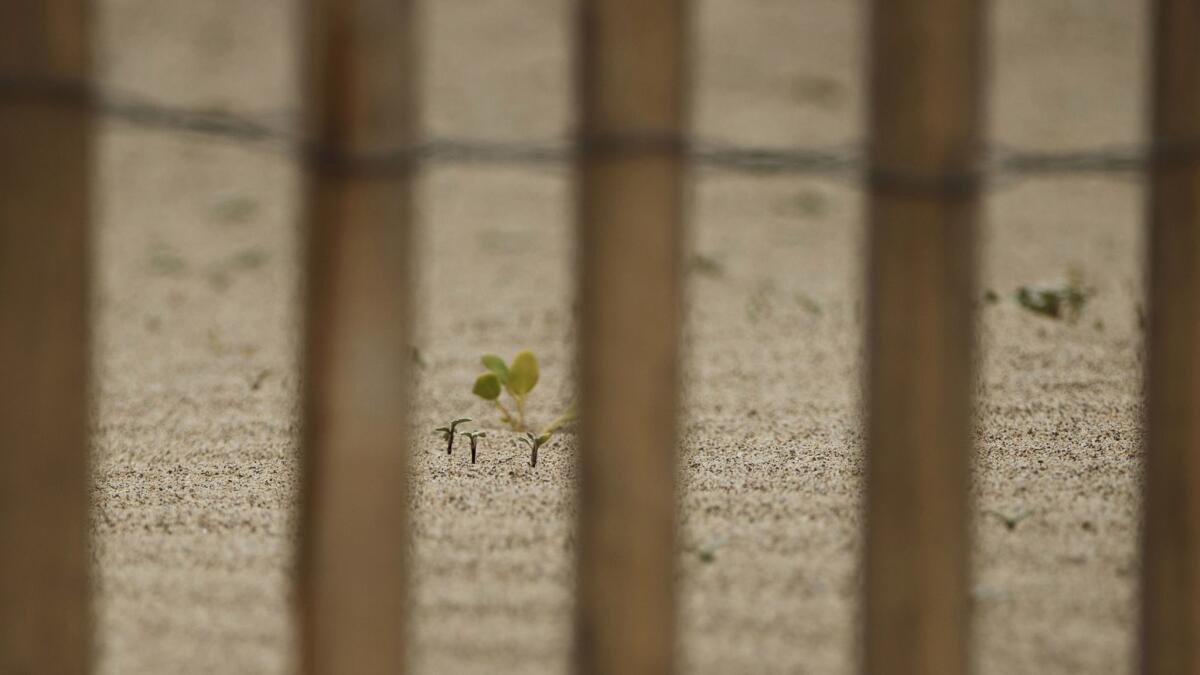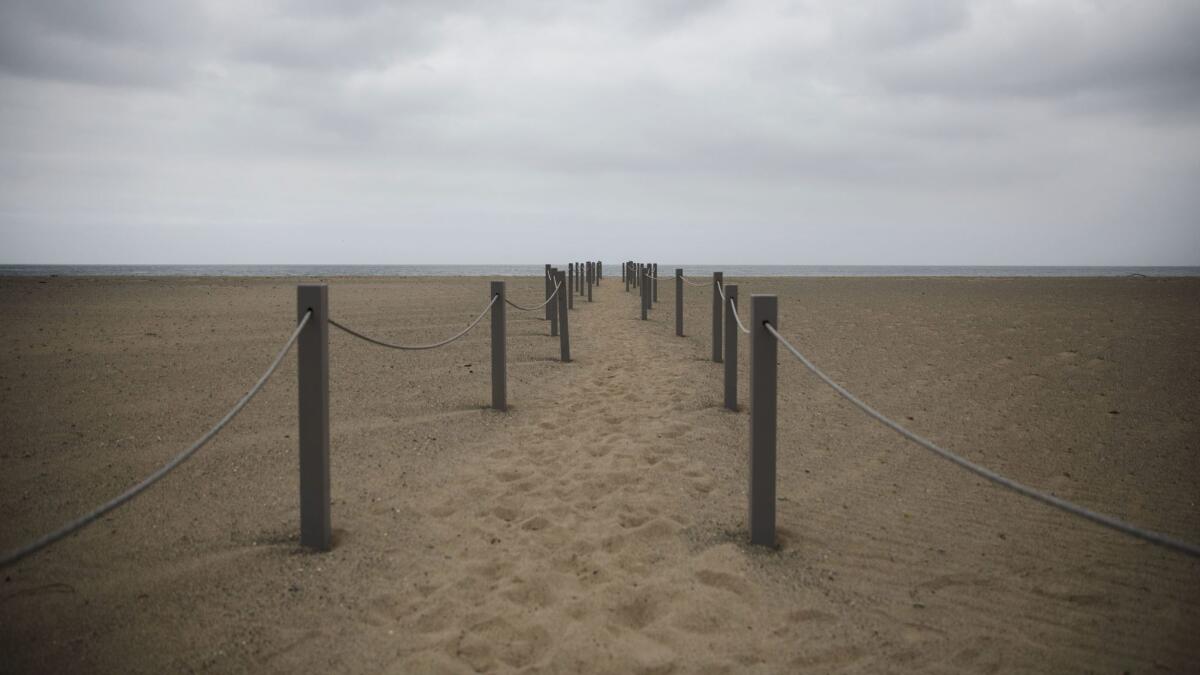Santa Monica’s new back-to-nature beach project has drawn the attention of rare birds. But can beach-goers let them live in peace?

No more grooming and sifting: Santa Monica Beach is going natural. (May 10, 2017) (Sign up for our free video newsletter here http://bit.ly/2n6VKPR)
- Share via
On a popular beach that is groomed, sifted and devoid of vegetation, Santa Monica officials and a local environmental group are restoring three acres of sand to a more natural state.
The city and the Bay Foundation have fenced off a swath of shoreline, planted native species and taken steps to build up the beach in hopes of creating a buffer against sea level rise and bringing back coastal plants and wildlife that are almost gone from the region.
Already, dune hummocks have formed, and about 10,000 seedlings that include flowering sand verbena and beach evening primrose dot the beach enclosure.
In mid-April, a pair of rare western snowy plovers nested in the restoration area, one of four such nests found on a Los Angeles County beaches — the first in almost 70 years.
Going back to what is wilder is a smarter way to go forward.
— Santa Monica Mayor Ted Winterer
Within 10 days, winds gusting to 40 mph covered the Santa Monica nest with sand and the snowy plovers abandoned it.
But officials remain encouraged about what the discovery says about their efforts.
“Going back to what is wilder is a smarter way to go forward,” Santa Monica Mayor Ted Winterer said during Tuesday’s dedication of the Santa Monica Beach Restoration Pilot Project. “The fact that snowy plovers are nesting is progress.”
The site is on a wide stretch of sand off Pacific Coast Highway just north of the Annenberg Community Beach House. It is bordered by the ocean and a 3-foot-tall fence of wood slates and wire.
Within the restoration area, the unsifted sand is darker than other parts of the beach. On the berm near the water’s edge, workers have left kelp and wood debris to help sand collect and provide havens for kelp flies and invertebrates that shorebirds feed on.
“This has been a chance for us to give back to the city and deal with environmental impacts that we will face in the future,” said Tom Ford, executive director of the Bay Foundation, a nonprofit organization that works to protect Santa Monica Bay.
The $70,000 project will be evaluated on its potential to combat sea level rise, check coastal erosion and its feasibility as a refuge for coastal vegetation and wildlife, including birds, insects and invertebrates — some of them rare.
Researchers also want to study whether recreational use of the beach can coexist with meaningful habitat restoration.
As part of the project, beach-goers are encouraged to walk through the site along a rope-lined path, but they must stay out of the restoration areas.
“How are people going to interact with it?” Ford said. “Are they going to be attracted to it? Are they going to be respectful of the wildlife and plant life?
Beach-goers are encouraged to walk through the site along a rope-lined path.

Beach restorations of various types have been successful along the California coastline.
Natural vegetation and wildlife have been restored at the state’s Asilomar Dunes Natural Preserve on the Monterey Peninsula.
A project at Surfers Point in Ventura expanded the beach, took measures to reduce erosion, used methods to control stormwater runoff and included a new bike path.
After the snowy plover nest was found in the Santa Monica restoration area, another was found at Dockweiler State Beach and two more were discovered on Malibu Lagoon State Beach.
These were the first plover nests found on a county beach since 1949. U.S. Fish and Wildlife Service biologists later placed wire screens around the nests to protect the eggs from predators and people.
“We are seeing snowy plovers nesting on L.A. County beaches against all odds,” said Chris Dellith, senior wildlife biologist with the U.S. Fish and Wildlife Service in Ventura. “It was a big surprise. We hope to see more success in the future.
Restoration projects such as the one Santa Monica has launched are a big help, officials said.
“Years of intensive management is paying off,” said Kimball Garrett, manager of the ornithology collection at the Natural History Museum of Los Angeles County. “The hope was always to give this species a chance to breed and then recolonize.”
The goal is to allow humans and shorebirds like the western snowy plover to peacefully coexist.
— Chris Dellith, senior wildlife biologist, U.S. Fish and Wildlife Service
The nesting season of the threatened western snowy plover runs from March through September and coincides with the period of greatest human beach use, Memorial Day through Labor Day.
Just weeks away from the long weekend that kicks off summer, the big question from federal biologists is this: Can sunbathers, surfers and developers give the western snowy plovers the peace and quiet they need to nest and raise their young?
“We’re seeking a balance between beach recreation and habitat restoration,” Dellith said. “The goal is to allow humans and shorebirds like the western snowy plover to peacefully coexist along our coastline.”
Though Santa Monica beaches have an estimated 17 million visitors a year, Winterer said the location of the restoration site probably won’t be degraded by the public because the area it is not as accessible nor as popular as stretches of sand south of the pier.


Twitter: @LADeadline16
Twitter: @LADeadline16
MORE LOCAL NEWS
In Venice, where money meets misery, hoping for an end to homeless camps
Rare birds find Southern California beach housing
The way California runs the Oroville Dam causes risk of flooding, area mayors say
Mavericks big wave contest plans to auction business assets amid bankruptcy proceedings
More to Read
Sign up for Essential California
The most important California stories and recommendations in your inbox every morning.
You may occasionally receive promotional content from the Los Angeles Times.















